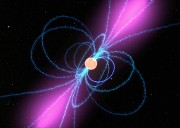Pulsars are the decayed carcasses of massive stars, which sweep a beam of electromagnetic radiation across the Earth as they rotate. The existence of neutron stars was postulated in the 1930s by Walter Baade and Fritz Zwicky, but it wasn’t until 1967 that Franco Pacini, writing in Nature, theorised that a rotating neutron star with a magnetic field would emit a beam of light that could be detected – a pulsar (Pacini 1967). The following year Jocelyn Bell, Antony Hewish and three other colleagues discovered such a signal, although they did not realise it at the time, dubbing their pulsing radio source ‘LGM-1’ for ‘Little Green Men’ (Hewish et al. 1968). It was Thomas Gold, also writing in Nature, who put two and two together, connecting Bell & Hewish’s Little Green Men signal with a theory of neutron star lighthouses similar to that of Pacini’s (Gold 1968). Hewish’s discovery eventually led to the 1974 Nobel Prize in Physics.
 In the early 1980s a new regime of pulsar astronomy opened up with the discovery of a pulsar with a period of just over one millisecond. Don Backer (Backer et al. 1982) brought significant insight into this burgeoning field by postulating that these pulsars, despite being very energetic and rotating rapidly, were old objects rather than young. He also suggested that the reason they were rotating so quickly was due to the presence of a binary companion spinning up the aged neutron star.
In the early 1980s a new regime of pulsar astronomy opened up with the discovery of a pulsar with a period of just over one millisecond. Don Backer (Backer et al. 1982) brought significant insight into this burgeoning field by postulating that these pulsars, despite being very energetic and rotating rapidly, were old objects rather than young. He also suggested that the reason they were rotating so quickly was due to the presence of a binary companion spinning up the aged neutron star.
More recently Paul Demorest and colleagues (Demorest et al. 2010) studied a millisecond pulsar in order to establish the mass of a neutron star. By measuring the increase in light-travel time for radio waves emitted from the pulsar as it passed through the curved space-time near the white dwarf companion, they calculated a mass of ~2 solar masses. This put a much-needed empirical constraint on the Tolman-Oppenheimer-Volkoff limit (the maximum mass of a neutron star, equivalent to the Chandrasekhar limit for white dwarf stars), which was thought at the time to be somewhere between 1.5 and 3 solar masses. They also used these measurements to rule out various equations of state for the neutron star.

